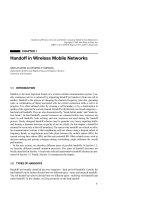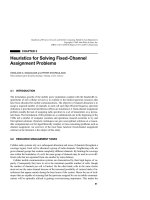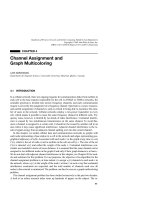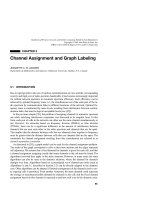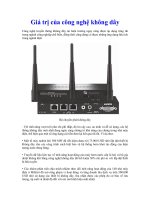Tài liệu Sổ tay của các mạng không dây và điện toán di động P1 pdf
Bạn đang xem bản rút gọn của tài liệu. Xem và tải ngay bản đầy đủ của tài liệu tại đây (317.07 KB, 25 trang )
CHAPTER 1
Handoff in Wireless Mobile Networks
QING-AN ZENG and DHARMA P. AGRAWAL
Department of Electrical Engineering and Computer Science,
University of Cincinnati
1.1 INTRODUCTION
Mobility is the most important feature of a wireless cellular communication system. Usu-
ally, continuous service is achieved by supporting handoff (or handover) from one cell to
another. Handoff is the process of changing the channel (frequency, time slot, spreading
code, or combination of them) associated with the current connection while a call is in
progress. It is often initiated either by crossing a cell boundary or by a deterioration in
quality of the signal in the current channel. Handoff is divided into two broad categories—
hard and soft handoffs. They are also characterized by “break before make” and “make be-
fore break.” In hard handoffs, current resources are released before new resources are
used; in soft handoffs, both existing and new resources are used during the handoff
process. Poorly designed handoff schemes tend to generate very heavy signaling traffic
and, thereby, a dramatic decrease in quality of service (QoS). (In this chapter, a handoff is
assumed to occur only at the cell boundary.) The reason why handoffs are critical in cellu-
lar communication systems is that neighboring cells are always using a disjoint subset of
frequency bands, so negotiations must take place between the mobile station (MS), the
current serving base station (BS), and the next potential BS. Other related issues, such as
decision making and priority strategies during overloading, might influence the overall
performance.
In the next section, we introduce different types of possible handoffs. In Section 1.3,
we describe different handoff initiation processes. The types of handoff decisions are
briefly described in Section 1.4 and some selected representative handoff schemes are pre-
sented in Section 1.5. Finally, Section 1.6 summarizes the chapter.
1.2 TYPES OF HANDOFFS
Handoffs are broadly classified into two categories—hard and soft handoffs. Usually, the
hard handoff can be further divided into two different types—intra- and intercell handoffs.
The soft handoff can also be divided into two different types—multiway soft handoffs and
softer handoffs. In this chapter, we focus primarily on the hard handoff.
1
Handbook of Wireless Networks and Mobile Computing, Edited by Ivan Stojmenovic´
Copyright © 2002 John Wiley & Sons, Inc.
ISBNs: 0-471-41902-8 (Paper); 0-471-22456-1 (Electronic)
A hard handoff is essentially a “break before make” connection. Under the control of the
MSC, the BS hands off the MS’s call to another cell and then drops the call. In a hard hand-
off, the link to the prior BS is terminated before or as the user is transferred to the new cell’s
BS; the MS is linked to no more than one BS at any given time. Hard handoff is primarily
used in FDMA (frequency division multiple access) and TDMA (time division multiple ac-
cess), where different frequency ranges are used in adjacent channels in order to minimize
channel interference. So when the MS moves from one BS to another BS, it becomes im-
possible for it to communicate with both BSs (since different frequencies are used). Figure
1.1 illustrates hard handoff between the MS and the BSs.
1.3 HANDOFF INITIATION
A hard handoff occurs when the old connection is broken before a new connection is acti-
vated. The performance evaluation of a hard handoff is based on various initiation criteria
[1, 3, 13]. It is assumed that the signal is averaged over time, so that rapid fluctuations due
to the multipath nature of the radio environment can be eliminated. Numerous studies
have been done to determine the shape as well as the length of the averaging window and
the older measurements may be unreliable. Figure 1.2 shows a MS moving from one BS
(BS
1
) to another (BS
2
). The mean signal strength of BS
1
decreases as the MS moves away
from it. Similarly, the mean signal strength of BS
2
increases as the MS approaches it. This
figure is used to explain various approaches described in the following subsection.
1.3.1 Relative Signal Strength
This method selects the strongest received BS at all times. The decision is based on a
mean measurement of the received signal. In Figure 1.2, the handoff would occur at posi-
tion A. This method is observed to provoke too many unnecessary handoffs, even when
the signal of the current BS is still at an acceptable level.
1.3.2 Relative Signal Strength with Threshold
This method allows a MS to hand off only if the current signal is sufficiently weak (less
than threshold) and the other is the stronger of the two. The effect of the threshold depends
2
HANDOFF IN WIRELESS MOBILE NETWORKS
BS
1
BS
2
MS BS
1
BS
2
MS
a. Before handoff b. After handoff
Figure 1.1 Hard handoff between the MS and BSs.
on its relative value as compared to the signal strengths of the two BSs at the point at
which they are equal. If the threshold is higher than this value, say T
1
in Figure 1.2, this
scheme performs exactly like the relative signal strength scheme, so the handoff occurs at
position A. If the threshold is lower than this value, say T
2
in Figure 1.2, the MS would de-
lay handoff until the current signal level crosses the threshold at position B. In the case of
T
3
, the delay may be so long that the MS drifts too far into the new cell. This reduces the
quality of the communication link from BS
1
and may result in a dropped call. In addition,
this results in additional interference to cochannel users. Thus, this scheme may create
overlapping cell coverage areas. A threshold is not used alone in actual practice because
its effectiveness depends on prior knowledge of the crossover signal strength between the
current and candidate BSs.
1.3.3 Relative Signal Strength with Hysteresis
This scheme allows a user to hand off only if the new BS is sufficiently stronger (by a hys-
teresis margin, h in Figure 1.2) than the current one. In this case, the handoff would occur
at point C. This technique prevents the so-called ping-pong effect, the repeated handoff
between two BSs caused by rapid fluctuations in the received signal strengths from both
BSs. The first handoff, however, may be unnecessary if the serving BS is sufficiently
strong.
1.3.4 Relative Signal Strength with Hysteresis and Threshold
This scheme hands a MS over to a new BS only if the current signal level drops below a
threshold and the target BS is stronger than the current one by a given hysteresis margin.
In Figure 1.2, the handoff would occur at point D if the threshold is T
3
.
1.3 HANDOFF INITIATION
3
BS
1
Signal Strength
h
T
1
ABC D
Signal Strength
BS
2
MS
T
2
T
3
Figure 1.2 Signal strength and hysteresis between two adjacent BSs for potential handoff.
1.3.5 Prediction Techniques
Prediction techniques base the handoff decision on the expected future value of the re-
ceived signal strength. A technique has been proposed and simulated to indicate better re-
sults, in terms of reduction in the number of unnecessary handoffs, than the relative signal
strength, both without and with hysteresis, and threshold methods.
1.4 HANDOFF DECISION
There are numerous methods for performing handoff, at least as many as the kinds of state
information that have been defined for MSs, as well as the kinds of network entities that
maintain the state information [4]. The decision-making process of handoff may be cen-
tralized or decentralized (i.e., the handoff decision may be made at the MS or network).
From the decision process point of view, one can find at least three different kinds of
handoff decisions.
1.4.1 Network-Controlled Handoff
In a network-controlled handoff protocol, the network makes a handoff decision based on
the measurements of the MSs at a number of BSs. In general, the handoff process (includ-
ing data transmission, channel switching, and network switching) takes 100–200 ms. In-
formation about the signal quality for all users is available at a single point in the network
that facilitates appropriate resource allocation. Network-controlled handoff is used in
first-generation analog systems such as AMPS (advanced mobile phone system), TACS
(total access communication system), and NMT (advanced mobile phone system).
1.4.2 Mobile-Assisted Handoff
In a mobile-assisted handoff process, the MS makes measurements and the network makes
the decision. In the circuit-switched GSM (global system mobile), the BS controller (BSC)
is in charge of the radio interface management. This mainly means allocation and release of
radio channels and handoff management. The handoff time between handoff decision and
execution in such a circuit-switched GSM is approximately 1 second.
1.4.3 Mobile-Controlled Handoff
In mobile-controlled handoff, each MS is completely in control of the handoff process.
This type of handoff has a short reaction time (on the order of 0.1 second). MS measures
the signal strengths from surrounding BSs and interference levels on all channels. A hand-
off can be initiated if the signal strength of the serving BS is lower than that of another BS
by a certain threshold.
1.5 HANDOFF SCHEMES
In urban mobile cellular radio systems, especially when the cell size becomes relatively
small, the handoff procedure has a significant impact on system performance. Blocking
4
HANDOFF IN WIRELESS MOBILE NETWORKS
probability of originating calls and the forced termination probability of ongoing calls are
the primary criteria for indicating performance. In this section, we describe several exist-
ing traffic models and handoff schemes.
1.5.1 Traffic Model
For a mobile cellular radio system, it is important to establish a traffic model before ana-
lyzing the performance of the system. Several traffic models have been established based
on different assumptions about user mobility. In the following subsection, we briefly intro-
duce these traffic models.
1.5.1.1 Hong and Rappaport’s Traffic Model (Two-Dimensional)
Hong and Rappaport propose a traffic model for a hexagonal cell (approximated by a cir-
cle) [5]. They assume that the vehicles are spread evenly over the service area; thus, the lo-
cation of a vehicle when a call is initiated by the user is uniformly distributed in the cell.
They also assume that a vehicle initiating a call moves from the current location in any di-
rection with equal probability and that this direction does not change while the vehicle re-
mains in the cell.
From these assumptions they showed that the arrival rate of handoff calls is
H
=
O
(1.1)
where
P
h
= the probability that a new call that is not blocked would require at least one hand-
off
P
hh
= the probability that a call that has already been handed off successfully would re-
quire another handoff
B
O
= the blocking probability of originating calls
P
f
Ј = the probability of handoff failure
O
= the arrival rate of originating calls in a cell
The probability density function (pdf) of channel holding time T in a cell is derived as
f
T
(t) =
C
e
–
C
t
+ [ f
T
n
(t) +
␥
C
f
T
h
(t)] – [F
T
n
(t) +
␥
C
F
T
h
(t)] (1.2)
where
f
T
n
(t) = the pdf of the random variable T
n
as the dwell time in the cell for an originated
call
f
T
h
(t) = the pdf of the random variable T
h
as the dwell time in the cell for a handed-off
call
F
T
n
(t) = the cumulative distribution function (cdf) of the time T
n
F
T
h
(t) = the cdf of the time T
h
C
e
–
C
t
ᎏ
1 +
␥
C
e
–
C
t
ᎏ
1 +
␥
C
P
h
(1 – B
O
)
ᎏᎏ
1 – P
hh
(1 – P
f
Ј)
1.5 HANDOFF SCHEMES
5
1/
C
= the average call duration
␥
C
= P
h
(1 – B
O
)/[1 – P
hh
(1 – P
f
Ј)]
1.5.1.2 El-Dolil et al.’s Traffic Model (One-Dimensional)
An extension of Hong and Rappaport’s traffic model to the case of highway microcellular
radio network has been done by El-Dolil et al. [6]. The highway is segmented into micro-
cells with small BSs radiating cigar-shaped mobile radio signals along the highway. With
these assumptions, they showed that the arrival rate of handoff calls is
H
= (R
cj
– R
sh
)P
hi
+ R
sh
P
hh
(1.3)
where
P
hi
= the probability that a MS needs a handoff in cell i
R
cj
= the average rate of total calls carried in cell j
R
sh
= the rate of successful handoffs
The pdf of channel holding time T in a cell is derived as
f
T
(t) =
e
–(
C
+
ni
)t
+
e
–(
C
+
h
)t
(1.4)
where
1/
ni
= the average channel holding time in cell i for a originating call
1/
h
= the average channel holding time for a handoff call
G = the ratio of the offered rate of handoff requests to that of originating calls
1.5.1.3 Steele and Nofal’s Traffic Model (Two-Dimensional)
Steele and Nofal [7] studied a traffic model based on city street microcells, catering to
pedestrians making calls while walking along a street. From their assumptions, they
showed that the arrival rate of handoff calls is
H
=
Α
6
m=1
[
O
(1 – B
O
) P
h

+
h
(1 – P
f
Ј) P
hh

] (1.5)
where

= the fraction of handoff calls to the current cell from the adjacent cells
h
= 3
O
(1 – B
O
) P
I

P
I
= the probability that a new call that is not blocked will require at least one handoff
The average channel holding time T in a cell is
T
ෆ
= + + (1.6)
␣
1
(1 –
␥
) + ␥
␣
2
ᎏᎏ
d
+
C
␥
(1 + ␣
2
)
ᎏ
o
+
C
(1 +
␣
1
)(1 –
␥
)
ᎏᎏ
w
+
C
C
+
h
ᎏ
1 + G
C
+
ni
ᎏ
1 + G
6
HANDOFF IN WIRELESS MOBILE NETWORKS
where
1/
w
= the average walking time of a pedestrian from the onset of the call until he
reaches the boundary of the cell
1/
d
= the average delay time a pedestrian spends waiting at the intersection to cross
the road
1/
o
= the average walking time of a pedestrian in the new cell
␣
1
=
w
P
delay
/(
d
–
w
)
␣
2
=
o
P
delay
/(
d
–
o
)
P
delay
= P
cross
P
d
, the proportion of pedestrians leaving the cell by crossing the road
P
d
= the probability that a pedestrian would be delayed when he crosses the road
␥
=
H
(1 – P
f
Ј)/[
H
(1 – P
f
Ј) +
O
(1 – B
O
)]
1.5.1.4 Xie and Kuek’s Traffic Model (One- and Two-Dimensional)
This model assumes a uniform density of mobile users throughout an area and that a user
is equally likely to move in any direction with respect to the cell border. From this as-
sumption, Xie and Kuek [8] showed that the arrival rate of handoff calls is
H
= E[C]
c—dwell
(1.7)
where
E[C] = the average number of calls in a cell
c—dwell
= the outgoing rate of mobile users.
The average channel holding time T in a cell is
T
ෆ
= (1.8)
1.5.1.5 Zeng et al.’s Approximated Traffic Model (Any Dimensional)
Zeng et al.’s model is based on Xie and Kuek’s traffic model [9]. Using Little’s formula,
when the blocking probability of originating calls and the forced termination probability
of handoff calls are small, the average numbers of occupied channels E[C] is approximat-
ed by
E[C] Ϸ (1.9)
where 1/
is the average channel holding time in a cell.
Therefore, the arrival rate of handoff calls is
H
Ϸ
O
(1.10)
Xie and Kuek focused on the pdf of the speed of cell-crossing mobiles and refined pre-
vious results by making use of biased sampling. The distribution of mobile speeds of
handoff calls used in Hong and Rappaport’s traffic model has been adjusted by using
c—dwell
ᎏ
C
O
+
H
ᎏ
1
ᎏᎏ
C
+
c—dwell
1.5 HANDOFF SCHEMES
7
f *(v) = (1.11)
where f (v) is the pdf of the random variable V (speed of mobile users), and E[V] is the av-
erage of the random variable V.
f *(v) leads to the conclusion that the probability of handoff in Hong and Rappaport’s
traffic model is a pessimistic one, because the speed distribution of handoff calls are not
the same as the overall speed distribution of all mobile users.
Steele’s traffic model is not adaptive for an irregular cell and vehicular users. In Zeng
et al.’s approximated traffic model, actual deviation from Xie and Kuek’s traffic model is
relatively small when the blocking probability of originating calls and the forced termina-
tion probability of handoff calls are small.
1.5.2 Handoff Schemes in Single Traffic Systems
In this section, we introduce nonpriority, priority, and queuing handoff schemes for a sin-
gle traffic system such as either a voice or a data system [6–14]. Before introducing these
schemes, we assume that a system has many cells, with each having S channels. The chan-
nel holding time has an exponential distribution with mean rate
. Both originating and
handoff calls are generated in a cell according to Poisson processes, with mean rates
O
and
H
, respectively. We assume the system with a homogeneous cell. We focus our atten-
tion on a single cell (called the marked cell). Newly generated calls in the marked cell are
labeled originating calls (or new calls). A handoff request is generated in the marked cell
when a channel holding MS approaches the marked cell from a neighboring cell with a
signal strength below the handoff threshold.
1.5.2.1 Nonpriority Scheme
In this scheme, all S channels are shared by both originating and handoff request calls. The
BS handles a handoff request exactly in the same way as an originating call. Both kinds of
requests are blocked if no free channel is available. The system model is shown in Figure
1.3.
With the blocking call cleared (BCC) policy, we can describe the behavior of a cell as a
(S + 1) states Markov process. Each state is labeled by an integer i (i = 0, 1, ···, S), repre-
vf(v)
ᎏ
E[V]
8
HANDOFF IN WIRELESS MOBILE NETWORKS
S
.
.
2
1
Channels
H
O
Figure 1.3 A generic system model for handoff.
senting the number of channels in use. The state transition diagram is shown in Figure 1.4.
The system model is modeled by a typical M/M/S/S queueing model.
Let P(i) be the probability that the system is in state i. The probabilities P(i) can be de-
termined in the usual way for birth–death processes. From Figure 1.4, the state equilibri-
um equation is
P(i) = P(i – 1), 0 Յ i Յ S (1.12)
Using the above equation recursively, along with the normalization condition
Α
S
i=0
P(i) = 1 (1.13)
the steady-state probability P(i) is easily found as follows:
P(i) = P(0), 0 Յ i Յ S (1.14)
where
P(0) = (1.15)
The blocking probability B
O
for an originating call is
B
O
= P(S) = (1.16)
The blocking probability B
H
of a handoff request is
B
H
= B
O
(1.17)
Equation (1.16) is known as the Erlang-B formula.
A blocked handoff request call can still maintain the communication via current BS un-
til the received signal strength goes below the receiver threshold or until the conversation
is completed before the received signal strength goes below the receiver threshold.
ᎏ
(
O
S
+
!
S
H
)
S
ᎏ
ᎏᎏ
Α
S
i=0
ᎏ
(
O
i!
+
i
H
)
i
ᎏ
1
ᎏᎏ
Α
S
i=0
ᎏ
(
O
i!
+
i
H
)
i
ᎏ
(
O
+
H
)
i
ᎏᎏ
i!
i
O
+
H
ᎏ
i
1.5 HANDOFF SCHEMES
9
Figure 1.4 State transition diagram for Figure 1.3.
0
···
O
+
H
i
···
O
+
H
(i+1)
O
+
H
i
S
O
+
H
S
1.5.2.2 Priority Scheme
In this scheme, priority is given to handoff requests by assigning S
R
channels exclusively
for handoff calls among the S channels in a cell. The remaining S
C
(= S – S
R
) channels are
shared by both originating calls and handoff requests. An originating call is blocked if the
number of available channels in the cell is less than or equal to S
R
(= S – S
C
). A handoff re-
quest is blocked if no channel is available in the target cell. The system model is shown in
Figure 1.5.
We define the state i (i = 0, 1, ···, S) of a cell as the number of calls in progress for the
BS of that cell. Let P(i) represent the steady-state probability that the BS is in state i. The
probabilities P(i) can be determined in the usual way for birth–death processes. The perti-
nent state transition diagram is shown in Figure 1.6. From the figure, the state balance
equations are
Ά
(1.18)
Using this equation recursively, along with the normalization condition
Α
S
i=0
P(i) = 1 (1.19)
the steady-state probability P(i) is easily found as follows:
ᎏ
(
O
i!
+
i
H
)
i
ᎏ
P(0) 0 Յ i Յ S
C
P(i) =
Ά
ᎏ
(
O
+
i
H
!
)
S
i
C
H
i–S
C
ᎏ
P(0) S
C
Յ i Յ S (1.20)
0 Յ i Յ S
C
S
C
< i Յ S
i
P(i) = (
O
+
H
) P(i – 1)
i
P(i) =
H
P(i – 1)
10
HANDOFF IN WIRELESS MOBILE NETWORKS
S
.
S
C
.
.
2
1
Channels
H
O
Figure 1.5 System model with priority for handoff call.

